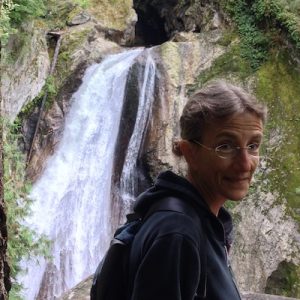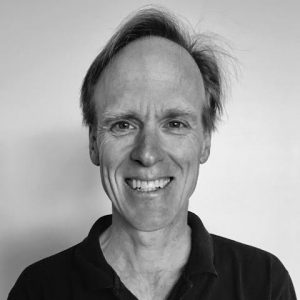Seattle is the site of SSA’s 2019 Annual Meeting. It’s also one of the major cities along the Cascadia Subduction Zone, the volatile seismic region that stretches from Northern California to Vancouver Island.
Formed by the Juan de Fuca, Gorda and Explorer plates dipping below the denser North American plate, the Cascadia Subduction Zone is one of few places in the world capable of generating a magnitude 9 megathrust earthquake, which in turn could produce a devastating tsunami similar to the one that struck Japan in 2011.
It’s no surprise, then, that subduction zone science will be a major discussion topic at the 2019 Annual Meeting. Two scientists looking forward to that discussion are Joan Gomberg and Michael Bostock, the meeting’s co-chairs.

Gomberg, a research geophysicist with the U.S. Geological Survey (USGS), has studied subduction zones since moving to Seattle 12 years ago.
“I was previously working for the USGS in Memphis, where I was focused on intraplate earthquakes,” she says. “When I moved to Seattle, it’s obviously a subduction zone and it’s fascinating, so it was natural to switch focuses.”
Bostock caught the “subduction zone bug” as a postdoctoral researcher working under the supervision of geophysicists Roel Snieder and Rinus Wortel on the PIONIER program, a subduction zone study that lasted from 1991 to 1996.
“The grant research was focused on a general understanding of subduction zones using seismology and geodynamical modelling, so it was quite open,” says Bostock. “That’s where the interest really grew.”
He took that experience with him when he interviewed at the University of British Columbia, where he’s now a professor of seismology in the Department of Earth, Ocean, and Atmospheric Sciences.
Cascadia – like other subduction zones – contains unique geologic activity that makes it an ideal place for Gomberg and Bostock to conduct their research.
For Gomberg, who works with the USGS’s Earthquake Hazard Program, the region offers an opportunity to study the impacts of earthquakes – both fast and slow.
“If there’s a fast slip across a fault, that generates an earthquake,” says Gomberg. “But we now know slips can occur very slowly and not radiate seismic waves.”
These silent – or aseismic – earthquakes have been found near many subduction zones, especially Cascadia. They occur over days, weeks or months as opposed to seconds or minutes.
“It’s a big topic of research to try understanding what the balance is between seismic and aseismic fault motions. The seismic ones knock down buildings and the silent ones don’t, so it’s an important distinction.”
Gomberg has also become involved in studying what goes on beneath the ocean, where “most of the geologic action” occurs in subduction zones. One area of interest has been underwater landslides.
“These provide us clues about past earthquakes, so I’ve been working with other people to try to understand what we can learn from these submarine landslides.”
The role of water in subduction zones has been a prominent focus of Bostock’s work, as well. His research has demonstrated that plate boundaries between 25 and 45 km in Cascadia and other subduction zones are characterized by fluid overpressures that may generate the slow-moving earthquakes known as “episodic tremor and slip,” or ETS.
“Many people are interested in ETS and its possible relation to megathrust earthquakes,” says Bostock. “Below 45 km, the fluids that create these overpressures are released into the overriding mantle wedge and change its bulk composition, called ‘serpentinization.’ Some fluids make it into the overriding plate and promote swarm seismicity.”

Bostock adds that the relationship between water and seismicity is an area “still rife for many discoveries.”
Instrumentation in and around the Cascadia Subduction Zone is another draw. He ranks the region as the second most densely instrumented subduction zone in the world behind Japan.
“Instrumentation is always improving,” he says. “There have also been major improvements in spatial sampling, which is so important in being able to resolve details in terms of subduction zone structure, as well as earthquake sources.”
Gomberg, too, is intrigued by technological improvements. She sees advances in technologies such as underwater drones, sensors on cables that lay on the sea floor, machine learning and even artificial intelligence as areas that will improve scientists’ ability to observe subduction zones.
For Gomberg and Bostock, however, one of the most important aspects of studying subduction zones is working with other scientists.
“It’s a global science and there’s a lot of collaboration,” says Gomberg. “There’s a big need to understand the processes, and you have to look globally.”
Bostock agrees, pointing to the American-led SZ4D Initiative. “It’s community driven, and the community is looking at trying to reinforce international partnerships and take a very wide look at subduction zones.”
According to Bostock, SZ4D aims to study not just Cascadia, but other regions in the world that are at a high risk of subduction zone earthquake disasters, though may not have the same resources to study them.
Both Gomberg and Bostock look to bring that collaborative and community-driven focus to the 2019 SSA Annual Meeting.
“The meeting will be an opportunity to highlight all the exciting things that are happening locally and regionally,” says Gomberg, who volunteered to be co-chair. “We want to bring together the community of researchers that are focused on the Pacific Northwest and subduction zones.”
She emphasizes, however, that subduction zones are not the exclusive focus by any means, pointing to other popular topics such as big data and machine learning.
Both Gomberg and Bostock also hope to bring in more disciplines and participants than have traditionally participated.
“We’d like to bring in researchers from Japan and other countries, seismologists and others who study Earth structure, geologists who study earthquakes, marine geophysicists, scientists who do laboratory experiments related to seismology and earthquakes, and geodesists,” says Gomberg.
Additionally, they aim to hold a session open to the general public to raise awareness about subduction zone science and seismology in the local community.
“I’m interested in how a meeting like this comes together,” says Bostock, who was asked by Gomberg to serve as co-chair. “I’m also looking forward, of course, to the science that will come. It’s very much a learning experience for me.”
The 2019 SSA Annual Meeting takes place 23-26 April in Seattle, Washington. Proposals for technical sessions will be accepted online mid-August.
